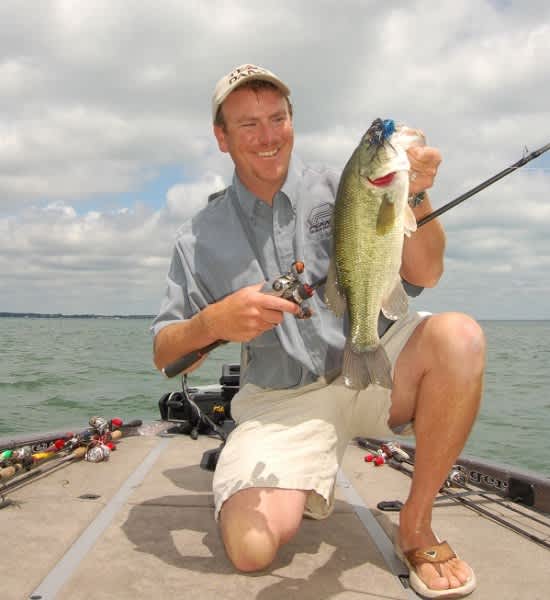Lake St. Clair Offers Prime Summer Bass Fishing
Bob Gwizdz 07.02.15

Ask 10 bass fishermen to rattle off the best bass lakes in Michigan and if nine of them don’t mention Lake St. Clair right off the bat, there’s something wrong with your sample. Lake St. Clair is and always has been one of the best bass lakes—and not only in Michigan, but in the country. In fact, it’s one of the best bass lakes in two countries, as Michigan shares the 430-square mile Great Lakes connecting water with Ontario, Canada.
St. Clair has everything a bass angler could want: vast shallow flats, huge shallow marshes, cuts and canals, and shipping channels. There are bulrushes and cattails, huge submerged weed beds of wild celery, cabbage, and acres of lily pads. There are rocky shoals and vast expanses of deep water—if you consider anything more than about 10 feet deep—that are intermittently carpeted with sand grass, giving huge schools of smallmouth bass a place to call home.
Known nationwide for its world-class smallmouth fishing, there are enough opportunities to catch largemouth bass in St. Clair that even if the smallies weren’t there, it would still be a darn good bass lake. From the backwater bays and marshes to the in-shore weed beds, there are thousands of acres of quality largemouth water.
I’ve enjoyed a number of days on the lake with many a fishing partner. When the wind was up and we couldn’t hold on the off-shore areas we’d hoped to prospect for smallmouths, we’ve tucked into backwater flats or the mouth of a tributary and enjoyed double-digit days when a lot of guys might have just packed it up and headed home.
Truth is, one of the tougher nuts to crack on Lake St. Clair is where to start.
The key to catching Lake St. Clair’s summer smallmouths, unless you’re fishing in the channels on the upper end of the lake, is to get off-shore. If you found fish in three to five feet of water, just start there and head to deeper water. Sometimes they’ll be in nine feet of water, sometimes in 12. Sometimes they’ll be even deeper. But you can get on an area known for bass fishing—say the Mile Roads along the Macomb County shoreline—and just work your way out, dragging a tube or a drop-shot rig until you find them. Then you can wail on them. Thirty-, 40-, or 50-fish days for a pair of anglers are not uncommon.
Jon Bondy, a veteran fishing guide who makes a fair portion of his living guiding bass fishermen on Lake St. Clair, says anglers should look for four things: rocks, subtle structure changes, changes in bottom composition, and bait.
“On St. Clair, there’s minimal structure in the lake, so they can be on glacial till—piles of small rocks that range from the size of your fist to the size of your head—and those piles will be small, maybe the size of your boat,” he said. “They dot the lake in 15 foot or less.”
Subtle depth changes are even harder to find.
“A lot of times you’ll be out there catching fish and you don’t know why but if you move around with your depthfinder on, you’ll notice there may be a six-inch drop over 100 yards. It doesn’t look like much, but on St. Clair, that’s all it takes.”
Changes in bottom composition are still harder to find. Bondy recommends turning the sensitivity on your depth finder all the way up until you see a double echo.
“If you’re running down the lake and it’s soft bottom, you won’t see the double echo,” he said. “But if you start seeing a double echo that’s hard bottom.”
Then there’s bait, which is easy to find because there’s so much of it.

“A lot of time you’ll see a line of bait all the way across the screen,” Bondy said. “Those are those schools of emerald shiners and nothing’s bothering them. But when that bait’s all balled up, top to bottom, there are bass underneath them. I generally won’t even fish a spot unless I see that.”
Once you’ve found an area to fish, deciding how can be mind-boggling. Tubes on jigheads are probably the most popular lures, but drop-shot rigs have caught on over the last decade and, in recent years, swim baits have come strong. But on any given day, anything can produce—jerkbaits, crankbaits, topwaters. The options are almost endless.
Gerry Gostenik, a full-time fishing guide/bass pro from Dearborn, agrees with Bondy about getting off shore, but he looks for something a little different.
“Look for subtle weed patches,” he said. “There’s a limited amount of structure out there so when you find those little weed patches, it can make all the difference in the world. There can be 25 or 30 bass sitting on a spot out there. And they can be anywhere.
“There’s more fish that utilize that main lake basin out there than people realize. It’s like a whole new lake—there are fish everywhere out there in the main lake and when I get on them the best is mid-July through late August. They pretty much stay there all summer.”
And that’s just in the summer. St. Clair can be just as good—even better—in spring and fall.
But that’s another story.
For more information on Michigan fishing go to michigan.org. Click here to purchase a Michigan fishing license online.
This article was produced in partnership with Pure Michigan.

